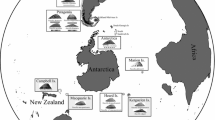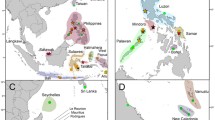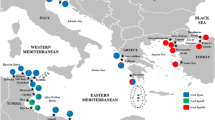Abstract
The tropical lancelet Asymmetron lucayanum (= Epigonichthys lucayanus) is distributed from the western Indian Ocean to the central Pacific Ocean, and the western Atlantic Ocean. Molecular phylogenetic analysis of mitochondrial cytochrome c oxidase subunit I (COI) sequences (1,035 bp) of A. lucayanum (80 specimens from seven localities) showed clearly that this species is genetically distinguished into three major groups of geographical populations based on neighbor-joining tree using maximum likelihood distance (HKY model with invariable sites and gamma correction), suggesting the existence of three cryptic species. Our genetic data show that (1) inter-oceanic divergence time between Clade B (the West-Central Pacific) and Clade C (the Atlantic) (d = 6.6%, ca. 12 million years ago) was smaller than intra-oceanic divergence time between Clade A (the Indo-West Pacific) and Clade B (d=39.5%, ca. 100 million years ago); (2) there are two cryptic species in the West Pacific in sympatry; and (3) high gene flow is implied between the Maldives and the Ryukyus in Clade A (10,000 km distance), the Philippines and Hawaii in Clade B (8,500 km distance), and Barbados and Bermuda in Clade C (2,200 km distance).




Similar content being viewed by others
References
Anderson RC (1998) Submarine topography of Maldivian atolls suggests a sea level of 130 metres below present at the last glacial maximum. Coral Reefs 17:339–341
Anderson FE (2000) Phylogeny and historical biogeography of the loliginid squids (Mollusca: Cephalopoda) based on mitochondrial DNA sequence data. Mol Phylogenet Evol 15:191–214
Andrews EA (1893) An undescribed acraniate: Asymmetron lucayanum. Stud Biol Lab Johns Hopkins Univ 5:213–247
Barber PH, Palumbi SR, Erdmann MV, Moosa MK (2000) Biogeography—a marine Wallace’s line? Nature 406:692–693
Bellwood DR, Wainwright PC (2002) The history and biogeography of fishes on coral reefs. In: Sale P (eds) Coral reef fishes. Dynamics and diversity in a complex ecosystem. Academic, San Diego, pp 5–32
Benzie JAH (1999) Genetic structure of coral reef organisms: Ghosts of dispersal past. Am Zool 39:131–145
Bigelow HB, Farfante IP (1948) Fishes of the western North Pacific. Lancelets. Mem Seas Found Mar Res 1:1–28
Blair JE, Hedges SB (2005) Molecular phylogeny and divergence times of deuterostome animals. Mol Biol Evol 22:2275–2284
Castelloe J, Templeton A (1994) Root probabilities for intraspecific gene trees under neutral coalescent theory. Mol Phylogenet Evol 3:102–113
Clement M, Posada D, Crandall KA (2000) TCS: a computer program to estimate gene genealogies. Mol Ecol 9:1657–1659
Colborn J, Crabtree RE, Shaklee JB, Pfeiler E, Bowen BW (2001) The evolutionary enigma of bonefishes (Albula spp.): cryptic species and ancient separations in a globally distributed shorefish. Evolution 55:807–820
Collin R (2000) Phylogeny of the Crepidula plana (Gastropoda: Calyptraeidae) cryptic species complex in North America. Can J Zool 78:1500–1514
Dawson MN, Jacobs DK (2001) Molecular evidence for cryptic species of Aurelia aurita (Cnidaria, Scyphozoa). Biol Bull 200:92–96
Excoffier L, Smouse PE, Quattro JM (1992) Analysis of molecular variance inferred from metric distances among DNA haplotypes—application to human mitochondrial-DNA restriction data. Genetics 131:479–491
Felsenstein J (1985) Confidence limits on phylogenies: an approach using the bootstrap. Evolution 39:783–791
Goetze E (2003) Cryptic speciation on the high seas; global phylogenetics of the copepod family Eucalanidae. Proc R Soc Lond Ser B 270:2321–2331
Grant WS, Bowen BW (1998) Shallow population histories in deep evolutionary lineages of marine fishes: insights from sardines and anchovies and lessons for conservation. J Hered 89:415–426
Hasegawa M, Kishino K, Yano T (1985) Dating the human-ape splitting by a molecular clock of mitochondrial DNA. J Mol Evol 22:160–174
Hay WW, DeConto R, Wold CN, Wilson KM, Voigt S, Schulz M, Wold-Rossby A, Dullo W-C, Ronov AB, Balukhovsky AN, Soeding E (1999) Alternative global Cretaceous paleogeography. In: Barrera E, Johnson C (eds) The evolution of Cretaceous ocean/climate systems. Geol Soc Am Spec Paper, 332, Boulder, pp 1–47
Hoare K, Goldson AJ, Giannasi N, Hughes RN (2001) Molecular phylogeography of the cosmopolitan bryozoan Celleporella hyalina: cryptic speciation? Mol Phylogenet Evol 18:488–492
Holland ND, Chen JY (2001) Origin and early evolution of the vertebrates: new insights from advances in molecular biology, anatomy, and palaeontology. Bioessays 23:142–151
Holland BS, Dawson MN, Crow GL, Hofmann DK (2004) Global phylogeography of Cassiopea (Scyphozoa : Rhizostomeae): molecular evidence for cryptic species and multiple invasions of the Hawaiian Islands. Mar Biol 145:1119–1128
Huelsenbeck JP, Crandall KA (1997) Phylogeny estimation and hypothesis testing using maximum likelihood. Ann Rev Ecol Syst 28:437–466
King JL, Hanner R (1998) Cryptic species in a “living fossil” lineage: taxonomic and phylogenetic relationships within the genus Lepidurus (Crustacea: Notostraca) in North America. Mol Phylogenet Evol 10:23–36
Kirkendale LA, Meyer CP (2004) Phylogeography of the Patelloida profunda group (Gastropoda: Lottidae): diversification in a dispersal-driven marine system. Mol Ecol 13:2749–2762
Kitaura J, Nishida M, Wada K (2002) Genetic and behavioral diversity in the Macrophthalmus japonicus species complex (Crustacea: Brachyura: Ocypodidae). Mar Biol 140:1–8
Knowlton N (1993) Sibling species in the sea. Ann Rev Ecol Syst 24:189–216
Knowlton N (2000) Molecular genetic analyses of species boundaries in the sea. Hydrobiologia 420:73–90
Lourie SA, Vincent ACJ (2004) A marine fish follows Wallace’s Line: the phylogeography of the three-spot seahorse (Hippocampus trimaculatus, Syngnathidae, Teleostei) in Southeast Asia. J Biogeogr 31:1975–1985
Martin AP, Naylor GJP, Palumbi SR (1992) Rates of mitochondrial-DNA evolution in sharks are slow compared with mammals. Nature 357:153–155
McCartney MA, Keller G, Lessios HA (2000) Dispersal barriers in tropical oceans and speciation in Atlantic and eastern Pacific sea urchins of the genus Echinometra. Mol Ecol 9:1391–1400
Miller K, Alvarez B, Battershill C, Northcote P, Parthasarathy H (2001) Genetic, morphological, and chemical divergence in the sponge genus Latrunculia (Porifera: Demospongiae) from New Zealand. Mar Biol 139:235–250
Miya M, Nishida M (1997) Speciation in the open ocean. Nature 389:803–804
Muhs DR, Simmons KR, Steinke B (2002) Timing and warmth of the Last Interglacial period: new U-series evidence from Hawaii and Bermuda and a new fossil compilation for North America. Quat Sci Rev 21:1355–1383
Nishikawa T (1979) A short report on the lancelet Asymmetron lucayanum Andrews, 1893 from Sesokojima Island, Okinawa (in Japanese). Biol Mag Okinawa 17:15–18
Nishikawa T (2004) A new deep-water lancelet (Cephalochordata) from off Cape Nomamisaki, SW Japan, with a proposal of the revised system recovering the genus Asymmetron. Zool Sci 21:1131–1136
Nishikawa T, Nishida M (1997) Problems in lancelet systematics. In: Kawashima S, Kikuyama S (eds) Advances in comparative endocrinology. Monduzzi Editore, Bolonga, pp 241–246
Nishikawa T, Shirai H, Chen Y, Dai C-F, Nohara M, Soong K (1997) First find of Epigonichthys maldivensis (Cooper) and rediscovery of E. lucayanus (Andrews) from Nanwan Bay, Southern Taiwan (Cephalochordata). Benthos Res 52:103–109
Nohara M, Nishida M, Manthacitra V, Nishikawa T (2004) Ancient phylogenetic separation between Pacific and Atlantic cephalochordates as revealed by mitochondrial genome analysis. Zool Sci 21:203–210
Nohara M, Nishida M, Nishikawa T (2005a) New complete mitochondrial DNA sequence of the lancelet Branchiostoma lanceolatum (Cephalochordata) and the identity of this species’ sequences. Zool Sci 22:671–674
Nohara M, Nishida M, Miya M, Nishikawa T (2005b) Evolution of the mitochondrial genome in Cephalochordata as inferred from complete nucleotide sequences from two Epigonichthys species. J Mol Evol 60:1–12
Palumbi SR (1992) Marine speciation on a small planet. Trend Ecol Evol 7:114–118
Palumbi SR, Grabowsky G, Duda T, Geyer L, Tachino N (1997) Speciation and population genetic structure in tropical Pacific sea urchins. Evolution 51:1506–1517
Posada D, Crandall KA (1998) Modeltest: testing the model of DNA substitution. Bioinformatics 14:817–818
Poss SG, Boschung HT (1996) Lancelets (Cephalochordata: Branchiostomatidae): How many species are valid? Israel J Zool 42:S13–S66
Saitou N, Nei M (1987) The neighbor-joining method—a new method for reconstructing phylogenetic trees. Mol Biol Evol 4:406–425
Sambrook J, Russell DW (2001) Preparation and analysis of eukaryotic genomic DNA molecular cloning. Cold Harbor Laboratory Press, New York, pp 6.4–6.11
Schneider S, Roessli D, Excoffier L (2000) Arlequin: a software for population genetics data analysis. Genetic and Biometry Laboratory, University of Geneva, Switzerland
Shulman MJ, Bermingham E (1995) Early-life histories, ocean currents, and the population-genetics of Caribbean reef fishes. Evolution 49:897–910
Smith AG, Smith DG, Funnell BM (1994) Atlas of Mesozoic and Cenozoic Coastlines. Cambridge University Press, Edinburgh
Swofford DL (2002) PAUP*, phylogenetic analysis using parsimony and other methods. Sinauer, Sunderland
Tachikawa H, Nishikawa T (1979) First finds of the circum-tropical lancelet Epigonichthys lucayanus (Andrews) from Chichijima Island, Ogasawara Islands, Japan (Cephalochordata) (in Japanese). Nanki Seibutu 39:145
Tajima F (1989) Statistical-method for testing the neutral mutation hypothesis by DNA polymorphism. Genetics 123:585–595
Tarjuelo I, Posada D, Crandall KA, Pascual M, Turon X (2001) Cryptic species of Clavelina (Ascidiacea) in two different habitats: harbours and rocky littoral zones in the northwestern Mediterranean. Mar Biol 139:455–462
Templeton AR, Crandall KA, Sing CF (1992) A cladistic-analysis of phenotypic associations with haplotypes inferred from restriction endonuclease mapping and DNA-sequence data. 3. Cladogram estimation. Genetics 132:619–633
Thompson JD, Gibson TJ, Plewniak F, Jeanmougin F, Higgins DG (1997) The Clustal X windows interface: flexible strategies for multiple sequence alignment aided by quality analysis tools. Nucleic Acids Res 25:4876–4882
Wada S, Oishi M, Yamada TK (2003) A newly discovered species of living baleen whale. Nature 426:278–281
Wickstead, JH (1975) Chordata: Acrania (Cephalochordata). In: Giese AC and Pearse JS (eds) Reproduction of marine invertebrates, vol 2. Academic, NY, pp. 283–319
Williams ST, Benzie JAH (1998) Evidence of a biogeographic break between populations of a high dispersal starfish: congruent regions within the Indo–West Pacific defined by color morphs, mtDNA, and allozyme data. Evolution 52:87–99
Wright JT, Zuccarello GC, Steinberg PD (2000) Genetic structure of the subtidal red alga Delisea pulchra. Mar Biol 136:439–448
Wu X, Zhang S, Wang Y, Zhang B, Qu Y, Jiang X (1994) Laboratory observation on spawning, fecundity and larval development of amphioxus (Branchiostoma belcheri tsingtaunese). Chin J Oceanol Limnol 12:289–294
Zigler KS, Lessios HA (2004) Speciation on the coasts of the new world: phylogeography and the evolution of bindin in the sea urchin genus Lytechinus. Evolution 58:1225–1241
Acknowledgements
Our cordial thanks are due to Dr. G. Rouse (University of Adelaide) for the material from the Great Barrier Reef, to Drs. E. Cutler (Harvard University), E. Ruppert (Clemson University), R. Langston (University of Hawaii), and Ms. A. Fukunaga (University of Hawaii) for kind help and advice for sampling, to Mr. Hassan Maaz Schareef of the Ministry of Fisheries, Agriculture and Marine Resources, Republic of Maldives for permission to collect the lancelets, to Mr. H. Tachikawa (Natural Museum and Institute, Chiba) for the photo, and to Drs. J.G. Inoue and Y. Yamanoue (ORI, University of Tokyo) for their helpful discussion regarding phylogenetic analyses during the preparation of this manuscript. This paper is Contribution #91 of the Bermuda Biodiversity Project, Bermuda Aquarium, Museum and Zoo. This study was financially supported by Grants-in-Aid from JSPS (Nos. 13440253, 15380131, 16370044, and 12NP0201), and NSF Grant DEB-0118804.
Author information
Authors and Affiliations
Corresponding author
Additional information
Communicated by T. Ikeda, Hakodate
Rights and permissions
About this article
Cite this article
Kon, T., Nohara, M., Nishida, M. et al. Hidden ancient diversification in the circumtropical lancelet Asymmetron lucayanum complex. Mar Biol 149, 875–883 (2006). https://doi.org/10.1007/s00227-006-0271-y
Received:
Accepted:
Published:
Issue Date:
DOI: https://doi.org/10.1007/s00227-006-0271-y




